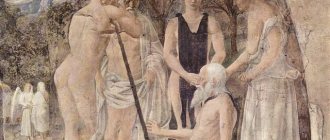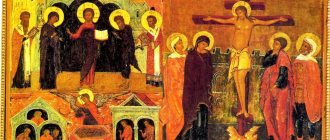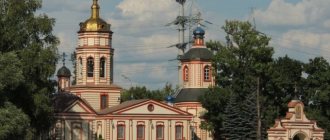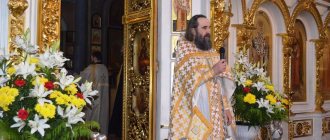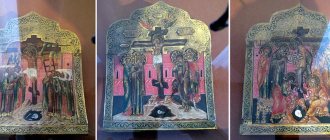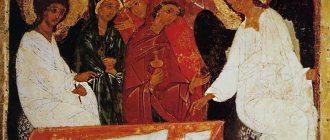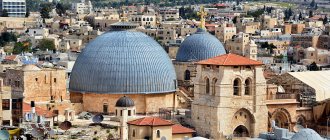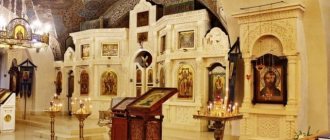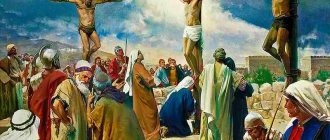The Church of the Holy Sepulcher (or the Resurrection of Christ) is the greatest shrine of the Christian world and the most important place of worship for believers. Millions of pilgrims and tourists strive to get here, and the annual descent of the Holy Fire is awaited with bated breath in different parts of the planet, watching the process live.
Ancient walls, © Konstantin Pavlov
According to the Ottoman Treaty of 1853, the territory of the temple was clearly divided between six Christian denominations: Greek Orthodox, Roman Catholic, Coptic, Armenian, Ethiopian and Syrian. The areas controlled by each of the churches remained within the boundaries they were at the time the document was signed. Not only the main shrines, chapels, altars and stairs are distributed, but also the time of services, the responsibilities of the parties and the rules for using common shrines are established. Now everything, even the most insignificant decisions, are made collectively. If at least one of the heads of the governing faiths expresses disagreement or doubt, then it will be impossible to perform even the most harmless action in the temple.
Due to the constant emergence of disputes, it often came to hand-to-hand combat, and they occurred not only in the distant Middle Ages, but also in the more civilized 21st century. Today, the main temple relics are owned by the Jerusalem Patriarchates of the Greek Orthodox and Armenian Apostolic Churches, as well as the Catholic monastic order of the Franciscans. The administrative buildings of the religious complex house the headquarters of the Jerusalem Orthodox Church.
Frankish Chapel, © Konstantin Pavlov
Main shrines
The complex of the Church of the Holy Sepulcher includes:
- Katholikon - an Orthodox church within a church;
- The Holy Sepulcher is the Savior’s funeral bed and the main altar;
- Golgotha is the hill where Jesus Christ was crucified;
- Edicule - a compact chapel in the Rotunda;
- The Stone of Confirmation is a consecrated copy of the slab (5 m long, 70 cm wide) on which Jesus was laid when he was taken down from the cross.
Catholicon, © Yucatan
Calvary
One of the two main shrines of the Christian world. Christ was crucified on the hill and, according to legend, Adam was buried. Golgotha was located outside of ancient Jerusalem and was used as a place for executing criminals. The rock is believed to have been formed from their skulls.
Edicule
The shrine is a small chapel with a dome. Inside there are two chapels: the Angel and the Holy Sepulcher with a stone bed. In the first there is a fragment of a stone placed on a pedestal, rolled away from the cave of Christ by an Angel, and two holes in the walls. The Holy Fire is transmitted through the north to the Orthodox, and through the south to the Armenians. On the western side of the Edicule is the chapel of the Copts.
The chapel was rebuilt several times. The last restoration was carried out in 2016–17. The walls of the chapel are made of white-yellow-pink marble, the facade is richly decorated, and unquenchable candles and lamps are installed near the Holy Sepulcher.
The Edicule is shared by Orthodox Greeks, Armenians and Catholics.
Edicule, © Official website of the Jerusalem Patriarchate
Descent of the Holy Fire in the Church of the Holy Sepulcher
A special service is held annually on Holy Saturday, the eve of Orthodox Easter. The descent of the Holy Fire and its removal from the Edicule symbolizes the risen Christ. Fire is delivered to Orthodox churches in other countries on special flights.
Side chapels
There are several chapels on the territory of the complex, including:
- Adam - with the head of Adam, which received the blood of Christ during the crucifixion;
- Crown of Thorns - with the crown placed on the head of Jesus in Praetorium;
- Finding the Life-Giving Cross - with the entrance to the Church of St. Helena;
- Divisions of vestments (Razdelisha) - with icons depicting scenes of division of the seamless tunic (type of clothing) of Christ;
- Mary Magdalene - with a marble circle marking the site of the appearance of the risen Jesus.
Under the arches of the Church of the Holy Sepulcher there are 5 stations of the Way of the Cross of Christ.
Adam's Chapel, © Official website of the Jerusalem Patriarchate
Edicule
At twelve o'clock in the afternoon, a procession of the cross begins to stretch from the courtyard of the Jerusalem Patriarchate to the Holy Sepulcher. It is led by the patriarch: having walked around the Edicule three times, he stops in front of its doors.
“The Patriarch dresses in white robes. With him, 12 archimandrites and four deacons put on white vestments at the same time. Then clerics in white surplices with 12 banners depicting the passion of Christ and His glorious resurrection come out of the altar in pairs, followed by clerics with ripids and a life-giving cross, then 12 priests in pairs, then four deacons, also in pairs, with the last two of them in front of the patriarch they hold bunches of candles in their hands in a silver stand for the most convenient transmission of the holy fire to the people, and, finally, the patriarch with a staff in his right hand. With the blessing of the patriarch, the singers and all the clergy, singing: “Thy Resurrection, Christ the Savior, the angels sing in heaven, and grant us on earth to glorify You with a pure heart,” go from the Church of the Resurrection to the edicule and circle it three times. After the third circumambulation, the patriarch, clergy and singers stop with the banner bearers and the crusader in front of the holy life-giving tomb and sing the evening hymn: “Quiet Light,” recalling that this litany was once part of the rite of the evening service.”
Description of the Church of the Holy Sepulcher
The central facade is made in the Romanesque style. Initially, there were two portals 5 m high and 3 m wide. The left one is still in use, and the right one was blocked with stone during the period of Muslim rule of Jerusalem.
On the left side of the Holy Door you can see a column with a crevice formed by a lightning strike at the time of the Descent of the Holy Fire in 1580. That year he did not appear to the Armenian Patriarch, who by cunning acquired the right to conduct the liturgy of the Descent of the Holy Fire. He went down to the Orthodox who remained outside the walls of the temple. Since then, the Greek Orthodox Patriarch has the exclusive right to liturgy. Representatives of other faiths have the opportunity to be present at the Edicule.
Crack in a column, © Konstantin Pavlov
The bas-reliefs that once decorated the building are now on display in one of the museums in Jerusalem. A wooden staircase can be seen under the second floor window. The Armenian monks climbed along it so as not to pass through the Greek Orthodox territory to their part of the temple. And although it has not been used for its intended purpose for a long time, the rarity is not removed, in accordance with the ban on any changes without unanimous permission.
To the right of the entrance is the chapel of the Franks, below it is the chapel of Mary of Egypt, and to the right is the door leading to the chapel of the Apostle John. In the northeastern part of the square there is an entrance to Golgotha, in the east there is the monastery of Abraham, in the west there is the Church of St. James and the chapel of the Myrrh-Bearing Women. To the south of the Holy Court is the Gethsemane courtyard, which houses a special relic - the shroud of the Virgin Mary.
Holy Court, © Official website of the Patriarchate of Jerusalem
Have attempts to find a scientific explanation for the Holy Fire been successful?
It is impossible to say that skeptics managed to defeat believers. Among the many theories that have physical, chemical and even alien justification, only one deserves attention. In 2008, physicist Andrei Volkov managed to get into Edicule with special equipment. There he was able to make the appropriate measurements, but their results were not in favor of science!
“A few minutes before the removal of the Holy Fire from the Edicule, a device recording the spectrum of electromagnetic radiation detected a strange long-wave pulse in the temple, which no longer appeared. I don’t want to refute or prove anything, but this is the scientific result of the experiment. An electrical discharge occurred - either lightning struck, or something like a piezo lighter turned on for a moment.”
History of the main Christian temple
A holy site outside ancient Jerusalem associated with Jesus Christ was revered by early Christians even after the destruction of the city by the Roman Emperor Titus in 70 and the creation in 135 of the Roman colony Aelia Capitolina by Emperor Hadrian within the boundaries of what is now the Old City. During that period, among other buildings, the Temple of Venus was erected, which was located above the Cave of the Holy Sepulcher.
The first Christian church appeared on the supposed site of Golgotha thanks to the efforts of the mother of Constantine I the Great, Helen. Being already at a fairly advanced age, she decided to go from Rome to Jerusalem, claiming that she had a vision “of divine places closed by the wicked, which she was ordered to bring to light.” According to legend, a local resident helped Elena find the Cave of the Holy Sepulcher, as well as find the Life-Giving Cross and other shrines.
Calvary and Holy Sepulcher, © Yupi666
Built under Constantine I the Great, the Church of the Resurrection was consecrated in 335. The richly decorated complex included:
- the temple-mausoleum of Anastasis with the Holy Sepulcher located in the center under a tent canopy;
- The Great Basilica with an altar facing Anastasis and a crypt (an underground vaulted room) built on the site of the discovery of the Life-Giving Cross.
The buildings stood unchanged for almost three centuries, until the capture of Jerusalem by the Persians in 614. The buildings significantly damaged by them were restored with the participation of the Byzantine emperor by 629, and 8 years later the city was forced to surrender to the army of the Righteous Caliphate on condition of preserving Christian shrines. Four centuries later, the Fatimid caliph broke the treaty and initiated the destruction of Christian churches, accompanied by massacres of believers. As a result, the basilica was irretrievably lost.
Golgotha, © Official website of the Jerusalem Patriarchate
The next stage in the history of the Church of the Holy Sepulcher occurred in the first half of the 11th century, after the Byzantine emperor Constantine VIII, in exchange for the construction of a mosque in Constantinople, managed to agree with another Muslim ruler on the restoration of a Christian shrine in Jerusalem. During that period, several separate chapels and the Church of the Resurrection were built in the form of a rotunda - a cylindrical structure covered with a dome.
The appearance and decoration of the newly built complex was strikingly different from the splendor of the first temple. This injustice was corrected by the crusaders in the middle of the 12th century. They erected a majestic building that united the holy places. It was consecrated in 1149. A five-tier bell tower was also installed, which sank to its present level as a result of the earthquake of 1545.
At the end of the 12th century, after the expulsion of the Crusaders from Jerusalem, Sultan Saladin gave the right to keep the keys to the Church of the Holy Sepulcher and its opening/closing to two different Muslim families of Arab origin. This helped to stop the disputes between the heads of Christian denominations about who should be the first to open the Holy Door. The tradition is still alive - the male representative of the Judeh family keeps the keys, and the male representative of the Nuseibeh family opens/closes the temple. Powers are transferred exclusively by inheritance.
Chapel of Divide, © Official website of the Jerusalem Patriarchate
During the fire of 1808, the Edicule and the tent over Anastasis were damaged. The restoration was carried out by a multinational group of architects. The wooden dome of the Rotunda was replaced with a metal one, giving it its original appearance.
Significant reconstruction was planned to be carried out in the middle of the last century, but due to the outbreak of World War II, the work was postponed to a later date. They started in 1959 and continued in the 1990s and 2010s. In 2013, the belfry was replenished with a bell cast in Russia.
An unprecedented step by the heads of Christian denominations was made in February 2021. In protest against the decision of the Israeli authorities to levy a city tax on church real estate and transfer part of the church lands to the state, the Church of the Holy Sepulcher was closed indefinitely. The issue was resolved within three days, after which the shrines were reopened to pilgrims.
Stone of Confirmation, © Official website of the Jerusalem Patriarchate
Physicist about the Holy Fire
The physicist himself did not set the goal of his research to expose the shrine. He was interested in the very process of the descent of fire: the appearance of flashes on the walls and on the lid of the Holy Sepulcher.
“So, it is likely that the appearance of Fire is preceded by an electrical discharge, and we, by measuring the electromagnetic spectrum in the temple, tried to catch it.”
This is how Andrey comments on what happened. It turns out that modern technology cannot solve the mystery of the sacred Holy Fire...
Services in the Temple
The schedule of services can be found at the Old Town gate leading to the Christian Quarter. At the Holy Sepulcher, liturgies are served alternately.
Greek Orthodox services:
- on Saturdays - at 23:00 (winter) and midnight (summer);
- on other days - at 23:30 (winter) and 00:30 (summer).
From 03:00 the liturgy is celebrated by the Armenian Church, and from 06:00 by Catholics.
The Divine Liturgy in the Katholikon begins at 07:00 (winter) and 08:00 (summer).
Transfer of the Holy Fire
In the first minutes after receiving fire, you can do whatever you want with it: believers wash themselves with it and touch it with their hands without fear of getting burned. After a few minutes, the fire turns from cold to warm and acquires its normal properties. Several centuries ago, one of the pilgrims wrote: “He lit 20 candles in one place and burned his candle with all those lights, and not a single hair curled or burned; and having extinguished all the candles and then lit them with other people, he lit those candles, and on the third day I lit those candles, and then I touched my wife with nothing, not a single hair was scorched or curled.”
Golgotha - place of executions
Golgotha is a hill where, during the life of Christ, criminals were executed by crucifixion - the most shameful death. Translated, Golgotha means “place of the forehead.” In the cliff of Golgotha, in a small cave, they guarded criminals being brought to execution. Here, sitting on a stone, Christ awaited crucifixion, which is why the place is called the Prison of Christ .
In the square in front of Golgotha, the gathered people watched the execution of the criminal. The bodies and crosses of those crucified were thrown into a hollow near the rock, where they also threw the Cross of the Lord, covering it with earth and stones. On the instructions of Saint Helena, they excavated and discovered a cave in which Jesus Christ was buried, the Life-giving Cross of the Lord, 4 nails and a tablet with the inscription: “INRI” (an abbreviation for Jesus of Nazareth, King of the Jews).
According to legend, Saint Helen discovered three crosses. To determine the real one, the crosses were applied one by one to the coffin of a recently deceased woman. When they touched the real one, the miracle of resurrection happened. The Church of the Holy Sepulcher was founded at the site of the find. The crosses of the thieves are indicated by black circles on the marble platform of Golgotha.
Catholicon
Katholikon is a Greek chapel, the largest and most beautiful part of the Church of the Resurrection of Christ, the cathedral. Internal dimensions are 22.3 meters long and 13.7 meters wide. Above the Katholikon rises a large dome (Rotunda), decorated with multi-colored mosaics. On the dome there is a cross of extraordinary beauty.
The carved iconostasis is decorated with icons in gold frames. A huge chandelier (lamp) with Byzantine symbols hangs above the center of the temple. Not far from the entrance to the Catholicon - the Navel of the Earth (Omphalus vase).
The Omphalus Vase is a flower-shaped stone bowl made of yellow marble, decorated with carvings. In the center of the bowl is a ball, symbolizing the Earth and the center of the Christian world. For Christians, the symbolic center of the Earth is forever linked to the site of Christ's ascension.
Access to the chalice is prohibited for pilgrims; its safety is monitored by monks from local monasteries. The bowl is so light that it had to be chained to prevent it from constantly moving.
Historical facts
The burial place of Christ has been revered since ancient times; we can say that even the very first Christians considered this place to be the holiest. Even during the construction of a huge church by Constantine I, his mother Elena carried out excavations, with the help of which they managed to obtain the Holy Sepulcher, nails and three crosses.
The Edicule in all the photos is presented in its most beautiful form, but few people know that the old building was destroyed in a fire that happened in 1808. Already in 1810, a new structure was built, which retains its appearance to this day. When renovating the building, the parameters of the cuvuklia, which is located in the Resurrection New Jerusalem Monastery, were taken as a basis. Unfortunately, in 1927, due to an earthquake, the condition of the structure was damaged. This event led to the fact that the building had to be strengthened along the side walls with beams. Thus, today pilgrims all over the world have the opportunity to venerate this landmark.
Excursions in Israel
- $60
Jerusalem of 3 religions - $65
Christian Jerusalem
- $50
Jerusalem panoramic view, Yad Vashem
